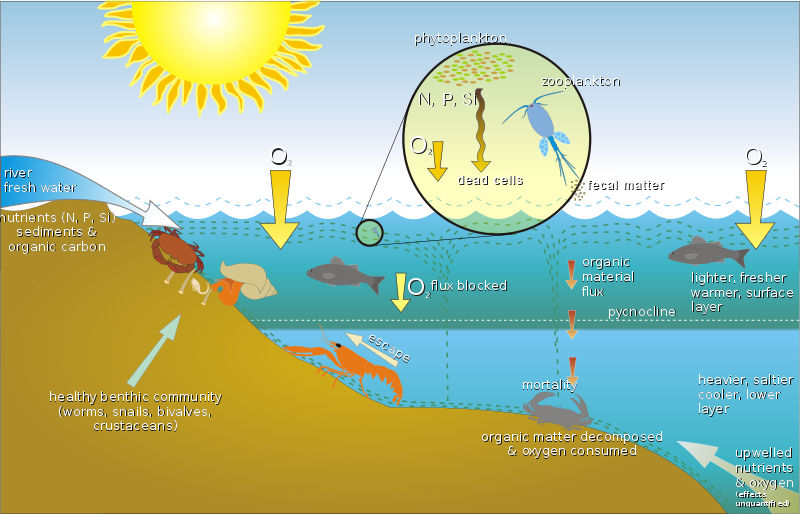Eutrophication is the process by which an aquatic environment is gradually enriched with nutrients, primarily phosphorus (P) and nitrogen (N).
Eutrophication is a natural process. Among other things, this process explains how a lake gradually turns into a swamp, then into a peat bog or a meadow. This process takes place over a very long period of time, typically tens of thousands of years. However, human activities can sometimes accelerate the eutrophication process, for instance when they release large amounts of phosphorus and nitrogen into the environment. A lake can then turn into a swamp within just a few decades. In this case, eutrophication is considered to be a form of contamination that impacts the quality of the water and aquatic ecosystem.
The natural eutrophication of a lake takes place in several stages.
-
It begins with a proliferation of aquatic plants, algae, phytoplankton, and photosynthetic bacteria (cyanobacteria). These plants are then so numerous that aquatic herbivores are unable to consume them all. A greenish film thus forms on the surface of the water, which blocks the light and prevents it from reaching other plant species that live in the deeper layers of the lake.
-
As deep plants can no longer photosynthesize, they die. They then settle to the bottom of the lake, where they will be broken down by bacteria and microorganisms.
-
As a result of the constant supply of organic matter at the bottom of lakes, bacteria multiply. They then use more oxygen to successfully decompose the excess organic matter. Dissolved oxygen becomes scarcer and aquatic animals suffer from it. Due to lack of oxygen, they stop reproducing and die. Even bacteria will die because they will eventually run out of oxygen. All these dead organisms accumulate at the bottom of the lake where they form a thick layer of silt.
-
Finally, the accumulation of sediment at the bottom of the lake will lead to its gradual degradation. The lake begins to turn into a swamp, then into a peat bog or a meadow.

The green dotted lines indicate the concentrations of organic matter in an ecosystem during the eutrophication process.
The eutrophication process is detected through a few signs: plant, algae, and bacteria growth, and the accumulation of dead organic matter. This process mainly affects lakes, but it has also been observed in rivers, bays, and gulfs.
The development of algae and phytoplankton is a sign of eutrophication.
The waters turn greenish or brownish.
When the balance of an aquatic ecosystem is disrupted by an excessive supply of nutrients, especially phosphates and nitrates, the eutrophication process is accelerated.
-
The proximity of a source of wastewater that is rich in these nutrients can therefore greatly impact an ecosystem. Agriculture, through the spreading of fertilizers and manure, is a major source of nutrients. Also, certain residential and industrial activities, such as using phosphate detergents, increase the input of nutrients into an environment.
-
Deforestation increases surface water runoff in a watershed. At the same time, the water becomes more nutrient-rich when it comes in contact with the soil. Runoff from farmland and populated areas enriches a lake with phosphorus and nitrogen, which triggers algae and phytoplankton blooms.
-
A disturbance in the oxygenation of the water also leads to an accelerated eutrophication. Some examples: a local weakening of currents reduces the oxygen renewal rate in a medium; an excessively high water temperature (between 15 and 25 °C) reduces the oxygen solubility; intense light level increases the water temperature.



